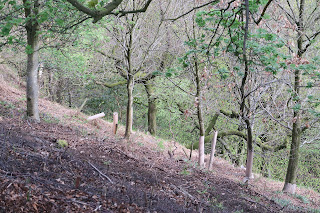Some of the mature Sycamores were "killed" a few years ago as part of the management of the upper clough and following this tubes were planted, which have been more successful than their contents, although some have saplings emerging shyly.
One small area has been successful with 14 oak trees appearing. One has to wonder why 14 were planted when there is only room on this ledge for perhaps 2 or 3 mature oaks. If left as is, they will all grow like spindles and none will make an attractive tree. Maybe there are plans to thin them at some later date--we will see.
Interesting way to kill the Sycamores. Not content with topping the trunk and removing all the crown, they have had 2 chainsaw rings around the trunk in an attempt at ring barking. Not satisfied with this, there was a more serious attempt at killing the tree by wholesale bark removal. But just to make sure, there have been ecoplugs drilled around the circumference. These plugs contain Glyphosate and kill the tree stone dead, preventing any regrowth. Of course, being drilled above the ringbarking they are useless as there is no sap flow connection to take Glyphosate to the roots. It all seems an expensive and bizarre way to create standing dead wood.
It would not have mattered if there had been some coppice type regrowth from the roots; it's all leaves, shelter and greenery and could be coppiced again after a few years.
I have included photos of Alder not far away from the planted tubes. Look how these have grown into really interesting trees, fascinating to look at and full of wildlife niches. But this is because they have space to grow.
In the lower clough, an earlier planting scheme of possibly 20 or 30 years ago is doing well. But the redundant tubes are scattered about and some are still around the trunks.
Come on--this is an attractive and designated wood why does it need plastic and Glyphosate?
Glyphosate plugs, ring barking and bark stripping. You will die or else!!
Many Oak saplings but will any grow into a tree?
Alder tree. Characterful after enjoying a good life in the open
Space to stretch ones limbs
A tree as tenement and testament
Growing well but what about those tubes?
Steep to plant but too steep to collect tubes








I agree with all of those musings Phillip. Perhaps with this new disdain for single-use plastic we will see less of those offensively ugly tubes. I have yet to start finding the old glyphosate plugs scattered around after the trees they have killed have crumbled into mould, but expect to do so soon. If volunteeers cant be motivated to go around removing the tightly-gripping tubes from successful plantings, or loose tubes kicking about where trees have failed, I can't imagine them being bothered to go out collecting plastic glyphosate plugs, but maybe I'm wrong on that. The traditional way to protect coppice shoots from grazing animals was simply to build a wigwam of cut branches over the stump. There are some sycamores near the bottom car park which I have pleaded with the Council to leave as they are. Their gnarled branches and tortuous air-borne roots twine and gesture like trees in Arthur Rackham illustrations - very picturesque.
ReplyDelete